Today, we will show you how to make our ultimate pickle brine recipe. It only requires 4 basic pickling ingredients: vinegar, water, salt and sugar. You can easily pickle any vegetable with this brine.
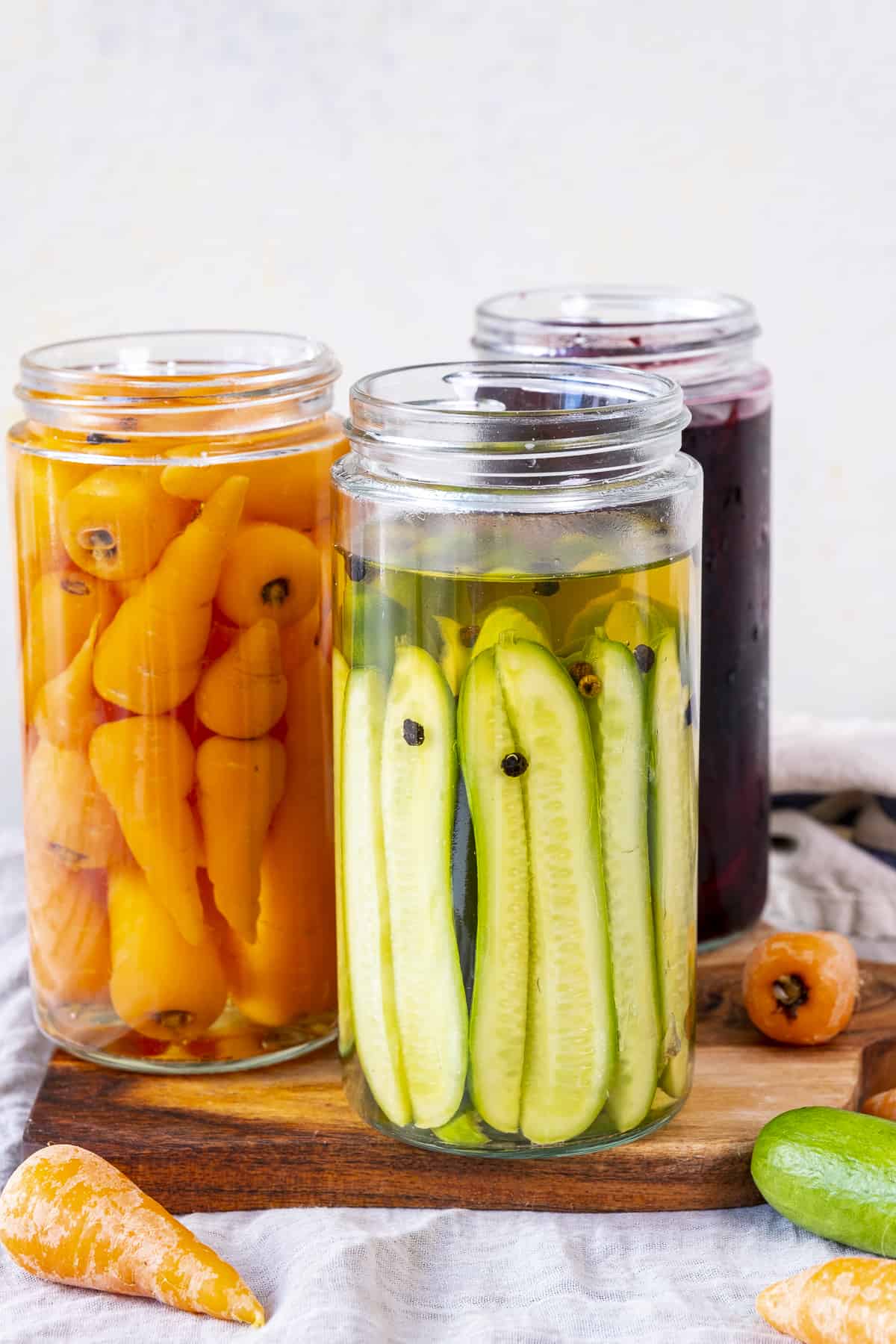
So, read on to learn all about this process so you can make your own pickles too. Start with our quick pickled cabbage if you want!
Jump to:
What Is Pickle Brine?
In the simplest explanation, pickle brine is the liquid used to help pickle (and ultimately preserve) fruits and vegetables. Yes, all types of fruits and vegetables!
This pickling liquid is made with a combination of water, vinegar, sugar and salt. There are some additional flavoring and functional ingredients. But, these four are essential in a basic pickle brine recipe.
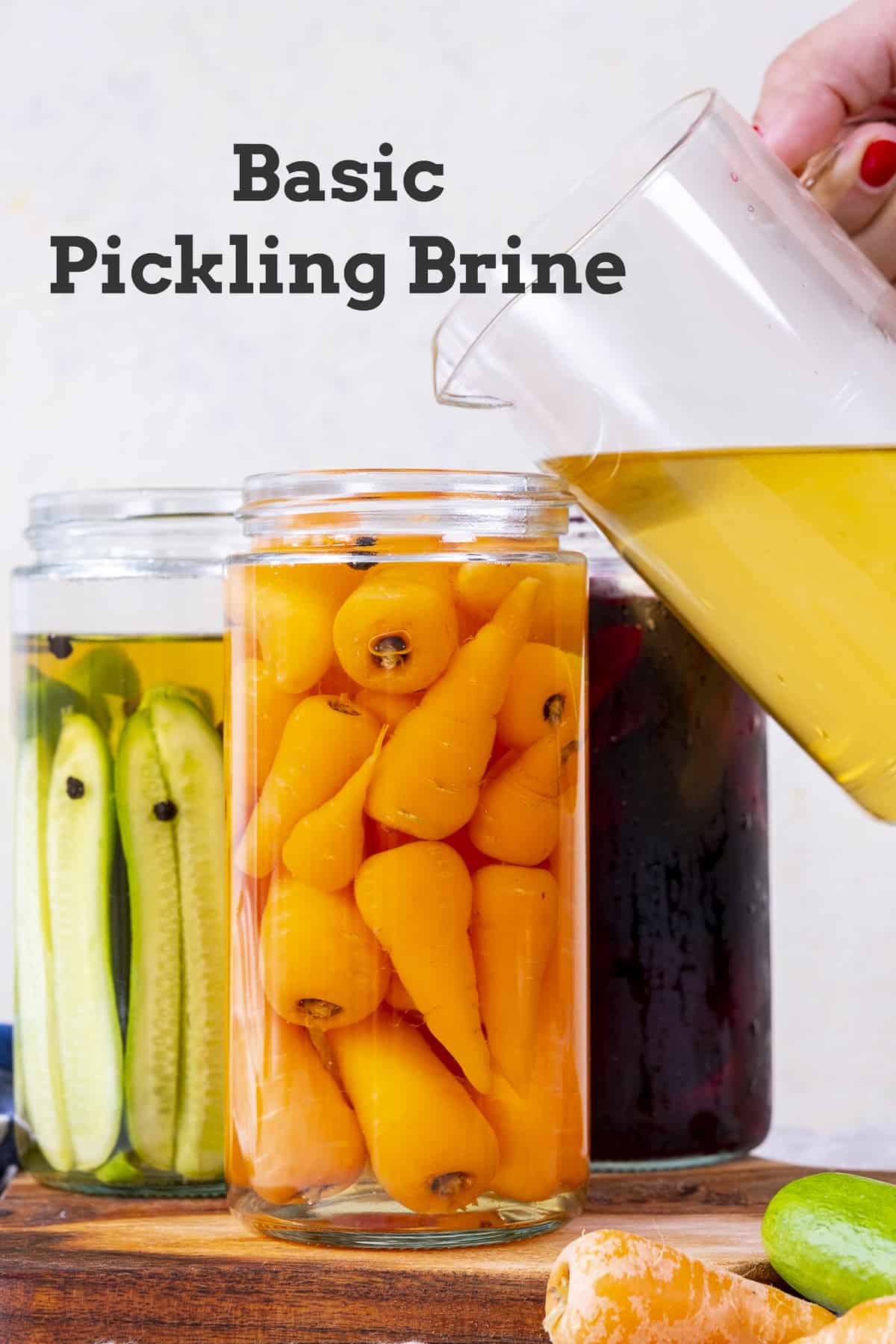
They help create a liquid in which fresh vegetables and fruits can be preserved for a long time. It creates an environment that is unlivable for mold. And simultaneously, they are flavored and get an uber-crisp texture too.
It is so easy to make homemade pickle brine that you don't really need to buy it from store. Let's see what we need.
Ingredients
A classic brine for pickles recipe always includes at least these four ingredients: water, vinegar, salt, and sugar.
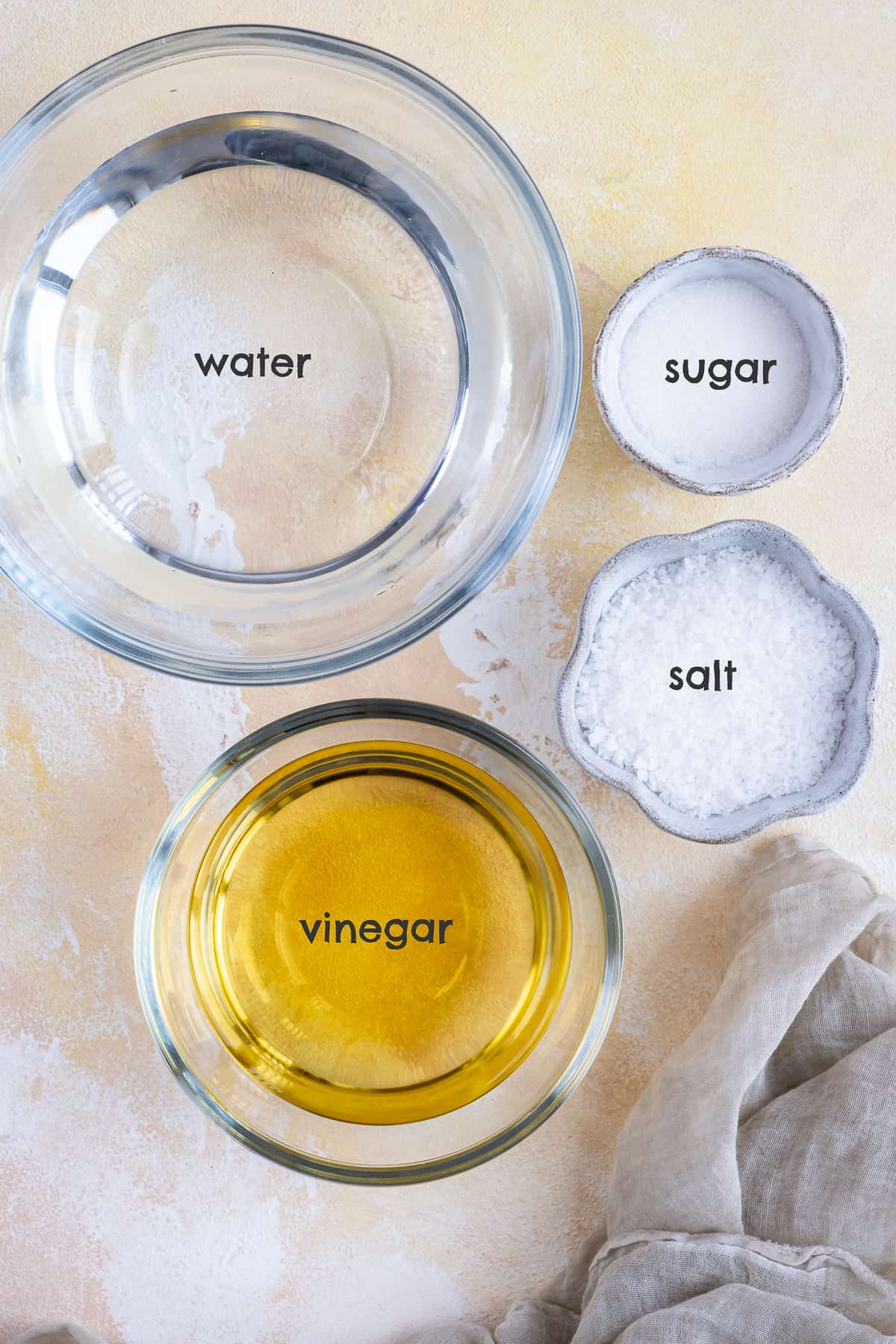
Water: It is added to help achieve the perfect pickling brine ratio, which is 50% water and 50% vinegar. It helps you have the right amount of acidity to work as a pickle (and prevent bacterial growth) but not overwhelm the flavor.
The remaining ingredients are more functional.
Vinegar: In this recipe, we use regular apple cider vinegar with a 5% acidity. But you can substitute it with any vinegar except balsamic vinegar or malt vinegar. Distilled white vinegar, white wine vinegar and rice vinegar work fine. Just keep in mind that the vinegar's flavor will be transferred to the pickling vegetables.
If you don't like the taste or smell of vinegar, you can use the same amount of lemon juice. If you are not sure about the acidity of the lemons, add in a little citric acid too.
Salt: Use kosher salt, sea salt or pickling salt. Don't use table salt for a brine as it contains iodine, anti-caking agents and additives, which might effect the quality of pickles you are making.
Sugar: This is not a sweet pickle brine recipe. It is more on the tangy side. A little sugar in our recipe gives a subtle sweetness to the tangy brine and pickles. Of course, you can completely leave it out if you don't want any sweetness.
Alternative Add-Ins
There is an endless amount of simple add-ins that will completely change the flavor of your brine. They can be added directly into the jars with the vegetables or into the brine liquid when it heats. Either way, you will add their flavor.
Some of the best pickling spices to add are whole spices like mustard seeds, coriander seeds, celery seeds, dill seeds, black peppercorns, allspice berries, cinnamon sticks. Also spices like red pepper flakes, bay leaf, and turmeric would be great additions. And, if you want to make it spicy, you can add some dried or fresh chili peppers too. And, to make your life easier, you can find pre-made pickling spice blends at the store.
Herbs are great additions too. Our favorites are fresh dill, parsley, rosemary, thyme or oregano. We don't recommend boiling them with the brine liquid. Place the herbs you want directly in the jars along with the vegetables and then pour the brine over them.
For even more flavor, you can also add aromatics like garlic, green onions (aka scallions), shallots or ginger into the jars.
How To Make
Now let's learn how to make an easy pickle brine from scratch. You only need a couple of ingredients to start with. But, the recipe we've developed allows you to play around with the spices and herbs as much as you'd like!
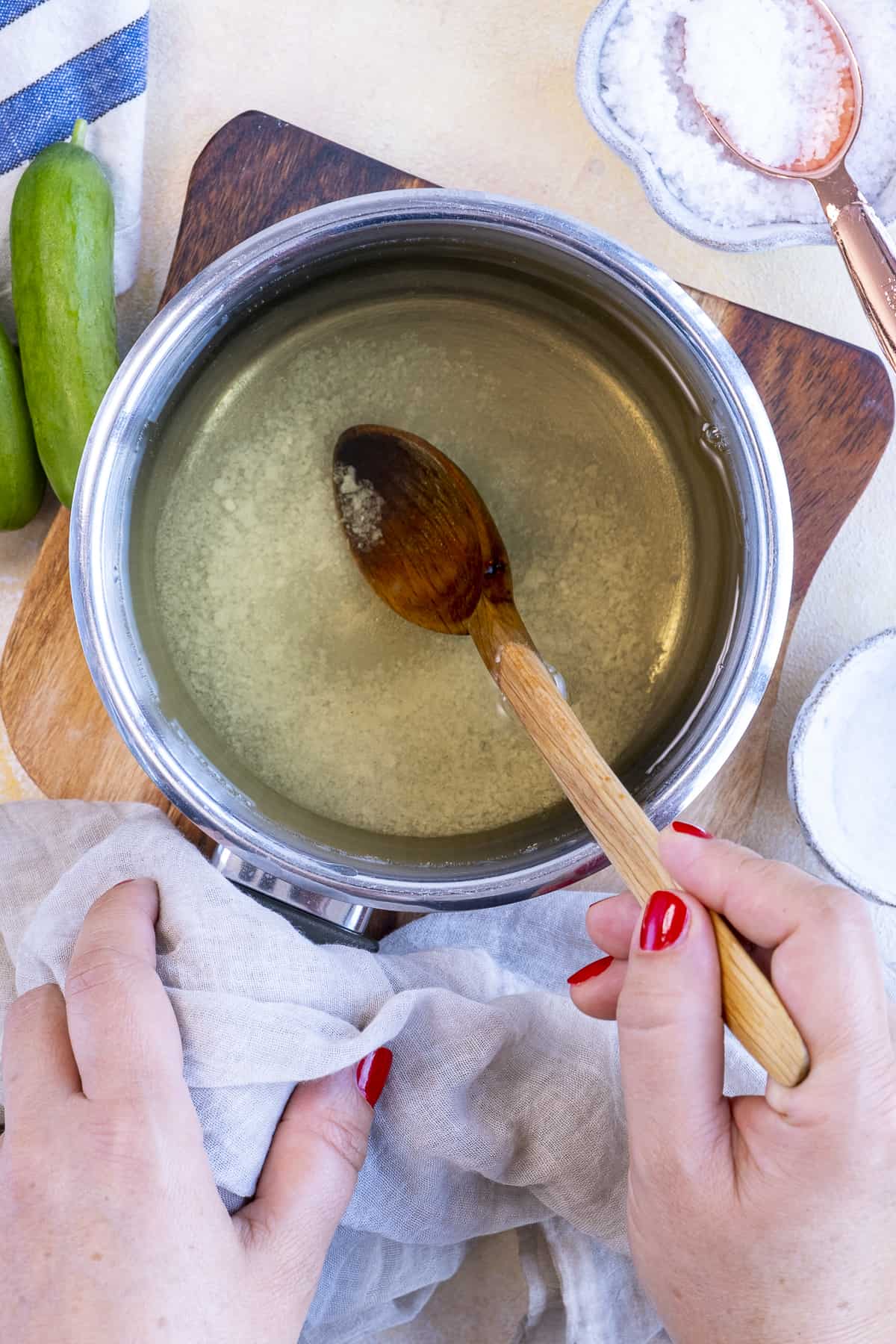
Boil the pickling liquid: To start, combine 2 cups water, 2 cups vinegar, 1 tablespoon sugar and 3 tablespoons kosher salt in a medium saucepan. If you want to add spices like mustard seeds, coriander seeds or dill seeds in your brine, add them in the saucepan at this step. Then bring it to a boil over medium-high heat. Double-check that all the sugar and salt are dissolved before moving on.
Cool the liquid slightly: Remove the saucepan from the heat and allow it to cool for about 5-10 minutes. Use it immediately to pickle vegetables like carrots, onions, cucumbers, radishes, green tomatoes or zucchini. We also love pickling beets with this brine.
How To Store
If you are not planning to use your pickle brine right away to make pickles, let it cool completely and store it in jars or containers with lids in the fridge to use later. It keeps well for up to 2 months.
When you are ready to use, heat it a bit if you are planning to make quick pickles aka refrigerator pickles. If you are planning to make fermented pickles, use it cold.
How To Use It For Pickling Vegetables
Our recipe can be used to make canned dill pickle recipe or as a quick pickle brine to make refrigerator pickles like our pickled cabbage.
This is an incredibly easy brine to use for virtually any vegetable. If you follow our recipe, you are making easy and fast pickles, which are ready in 1-2 days. These are uber-crunchy, flavorful, and tender to the core.
Before starting to make pickles, prepare your jars. Wash them in hot soapy water, rinse well and let them dry. You don't need to sterilize the jars for quick pickles.
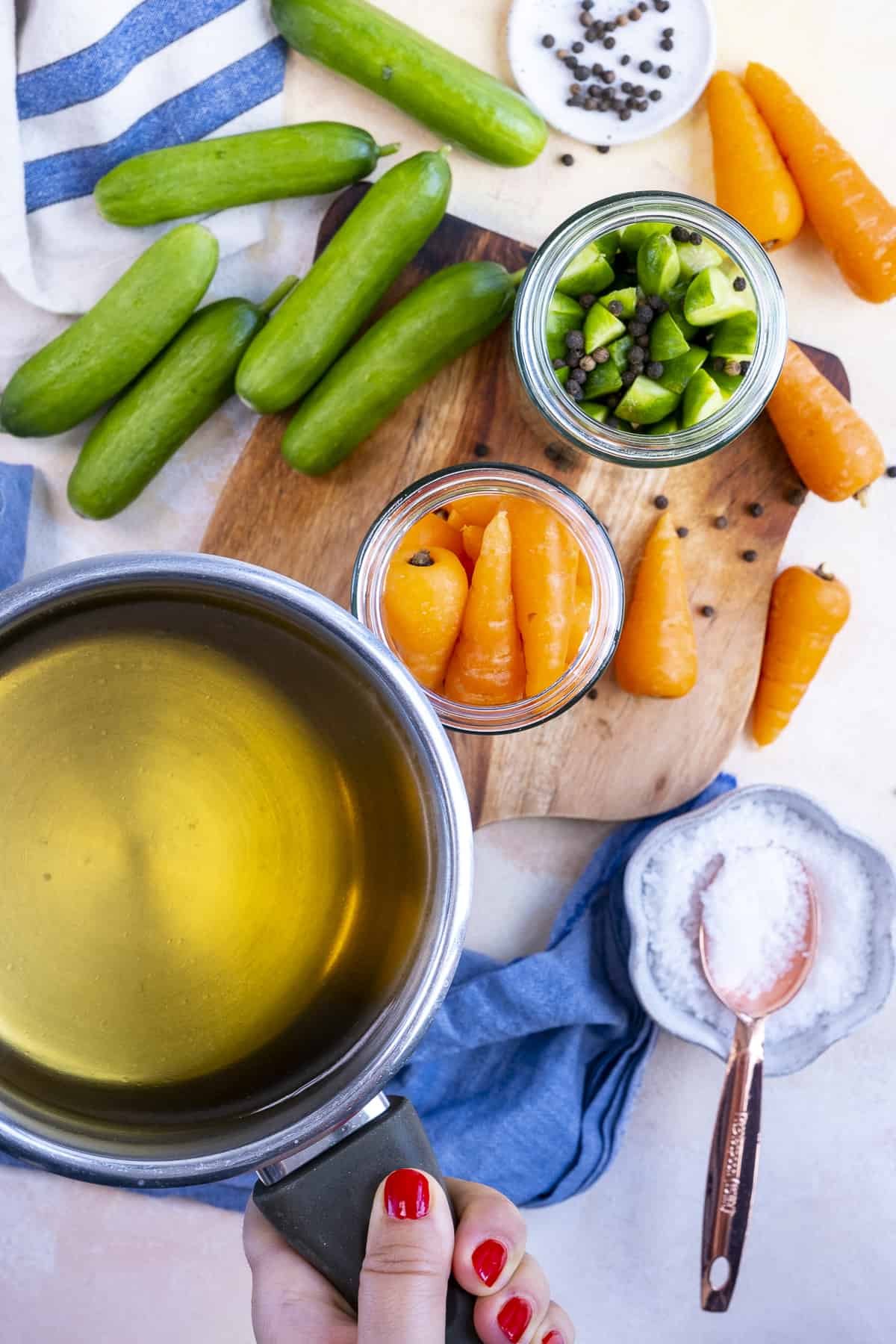
To quick pickle your vegetables: Place the vegetables into a jar. If you want, you can add a few cloves garlic and fresh dill in the jars. Then pour the warm brine over them, leaving about ½-inch space at the top. Tap the jar on a counter to remove any bubbles. Place the lids. Let them sit on the counter until they cool completely. Store them inside the fridge. Your pickles will be ready after 24 hours. They taste even better after 48 hours.
Enjoy your pickles in your sandwiches, burgers or hot dogs. They make great additions on salads too.
Reusing The Brine
Can you reuse the pickle brine when you finish the pickles in the jar? Yes, you can if it still looks good. To reuse the leftover brine, you need to heat it to make refrigerator pickles. Pour it in a saucepan and bring it to a boil.
If you think it won't be enough for the vegetables you want to pickle, you can use it to make a new batch of brine. For a small batch, combine it with 1 cup vinegar, 1 cup water, 1 tablespoon salt and 1 teaspoon sugar. The leftover brine will give a richer taste to your new brine.
Alternatively, you can use that leftover brine in salad dressings. It would be such a great addition in our creamy cucumber salad.
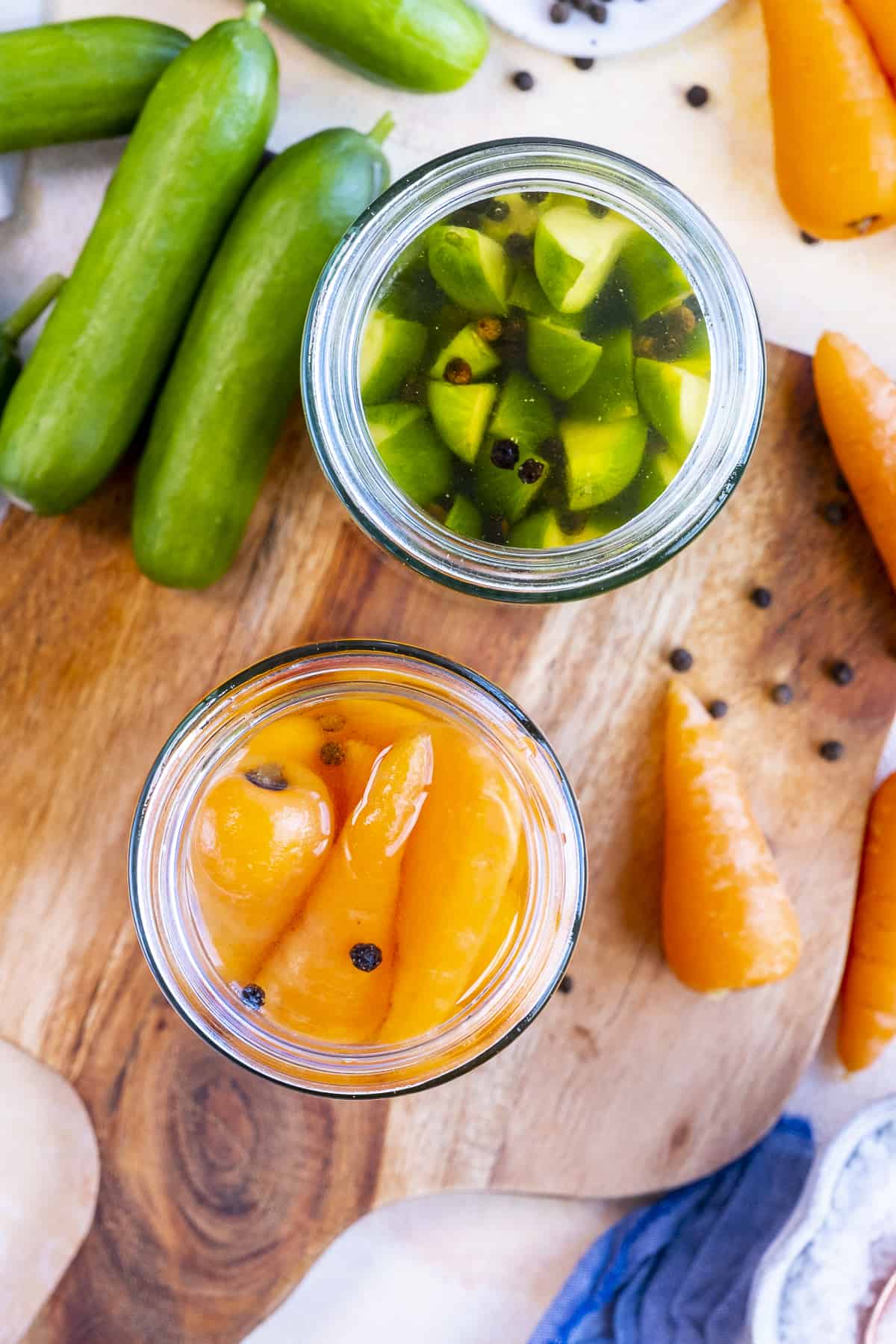
Tips
- The basic pickle brine ratio is 50:50, meaning equal parts of water and vinegar. But you can play with this ratio depending on your taste.
- The acidity of the vinegar you use should be at least 5%.
- You can use a combination of vinegars if you want.
- You can use less vinegar if you use another acidic ingredient like citric acid.
- Always use glass containers like mason jars to store your pickle brine or your pickles.
- Sugar is an optional addition but it balances the tangy flavor of vinegar, so we recommend it.
- Make sure to use kosher salt, sea salt or pickling salt.
- Pour the brine over the veggies in jars when it is still warm. This is necessary when making quick pickles.
- Make sure that all the veggies in jars are coated with the brine and leave a little space (½ inch) on the top.
- Let them cool completely and reach room temperature before storing in the refrigerator.
- Always use fresh vegetables when making pickles.
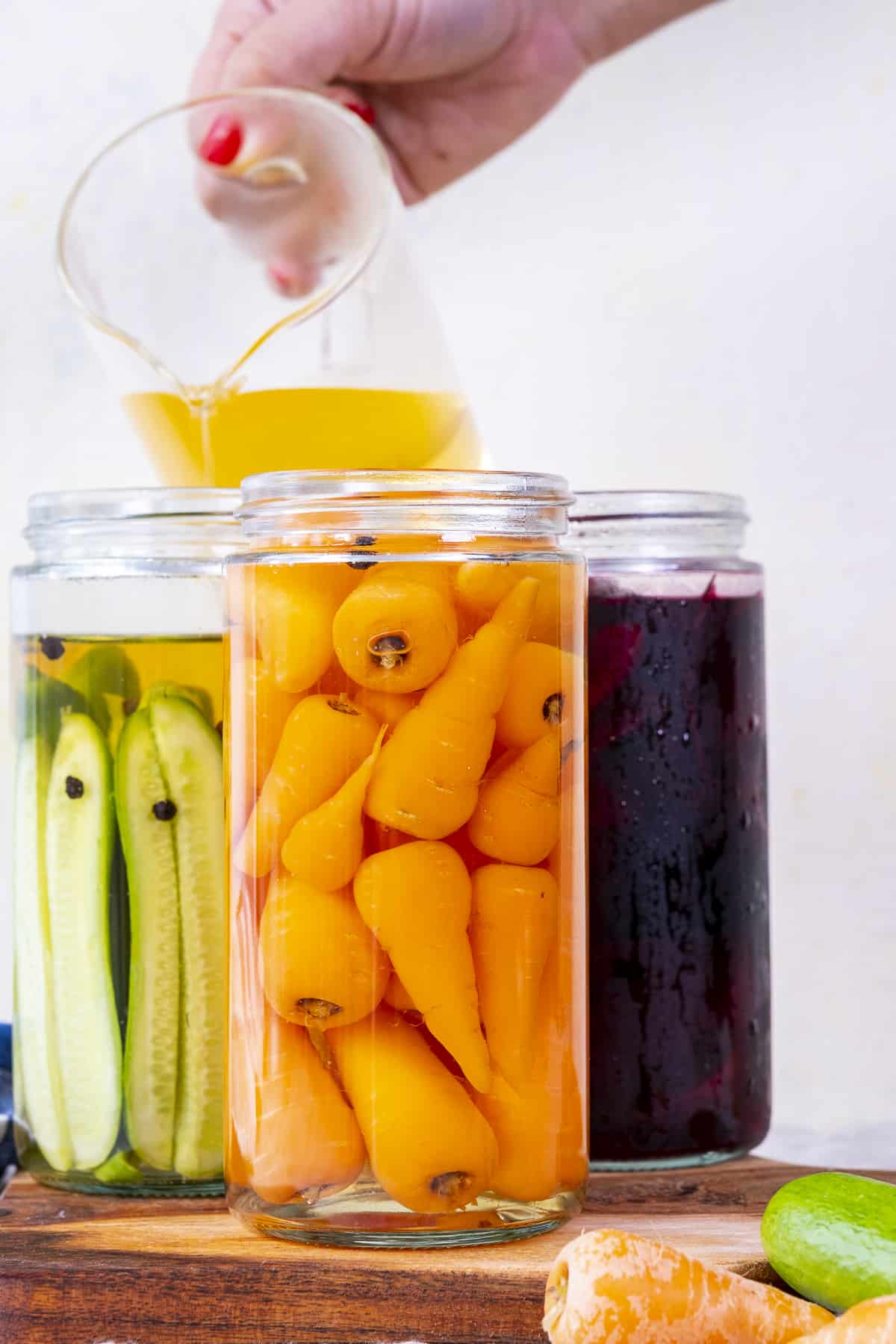
FAQs
Pickle juice is not the same as pickle brine. Pickle juice is the liquid in your pickle jar. The flavors have already developed considerably. However, you can also use that pickle juice to make pickle brine. The liquid is still completely safe to use. This is a way of reusing pickle brine to start a new batch.
This answer depends entirely on the pickling technique you use. The quickest recommended time to wait before eating your homemade pickles is a day. However, on average it takes about 2-3 days. Even then, there are still some pickling recipes and technique that requires the pickling cucumbers (or other vegetables) to rest for up to 3 weeks!
Cloudy brine is caused by too much lactic acid bacteria forming during the fermentation period. However, the pickling juice and vegetables are still perfectly safe to eat. It is actually something good as it is a sign of good fermentation. And no, the type of vinegar used doesn't affect the cloudiness. You can still use any cider vinegar or distilled vinegar that you'd like.
A homemade pickle brine won’t last forever. This brine will last (on average) about 2 months when kept in the fridge.
There are pros and cons to drinking pickle brine. It is loaded with nutrients but also with sodium. At the end of the day, in our opinion, everything in moderation and with the approval from your doctor should be perfectly fine.
More Recipes with Brine
As always: If you make this recipe, let us know what you think by rating it and leaving a comment below. And post a pic on Instagram too—tag @give_recipe so we can see!
Sign up for the FREE GiveRecipe Newsletter to get the new recipes into your inbox! And stay in touch with us on Facebook, Pinterest, YouTube and Instagram for all the latest updates.
📖 Recipe
Basic Pickle Brine Recipe With Vinegar
Basic pickle brine with 4 ingredients. You can make wonderfully crunchy pickles from any vegetable with this brine.
- Prep Time: 5 minutes
- Cook Time: 5 minutes
- Total Time: 10 minutes
- Yield: 2 jars 1x
- Category: Side Dish
- Method: Pickling
- Cuisine: American
Ingredients
- 2 cups water
- 2 cups vinegar (5% acidity)
- 2 tablespoons kosher salt or pickling salt
- 1 tablespoon sugar
Instructions
- Combine everything in a saucepan and bring it to a boil. Make sure to dissolve sugar and salt.
-
Remove from the heat and let it cool slightly for 5-10 minutes. Use it immediately for pickling vegetables or store it in the refrigerator until ready to use (up to 2 months).
-
To pickle vegetables: Put the veggies in jars. Pour the warm brine over them, Leave ½ inch at the top. Place the lids.
-
Let them cool completely and put the jars in the refrigerator after they are at room temperature. These pickles will be ready after 24 hours but taste better after 48 hours.
Notes
- The basic pickle brine ratio is 50:50, meaning equal parts of water and vinegar. But you can play with this ratio depending on your taste.
- The acidity of the vinegar you use should be at least 5%.
- You can use a combination of vinegars if you want.
- You can use less vinegar if you use another acidic ingredient like citric acid.
- Always use glass containers like mason jars to store your pickle brine or your pickles.
- Sugar is an optional addition but it balances the tangy flavor of vinegar, so we recommend it.
- Make sure to use kosher salt, sea salt or pickling salt.
- Pour the brine over the veggies in jars when it is still warm. This is necessary when making quick pickles.
- Make sure that all the veggies in jars are coated with the brine and leave a little space (½ inch) on the top.
- Let them cool completely and reach room temperature before storing in the refrigerator.
- Always use fresh vegetables when making pickles.
Nutrition
- Serving Size:
- Calories: 75
- Sugar: 7.2 g
- Sodium: 5601.5 mg
- Fat: 0 g
- Carbohydrates: 8.5 g
- Fiber: 0 g
- Protein: 0 g
- Cholesterol: 0 mg


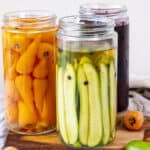
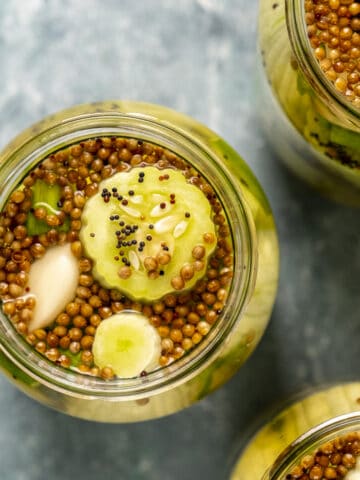
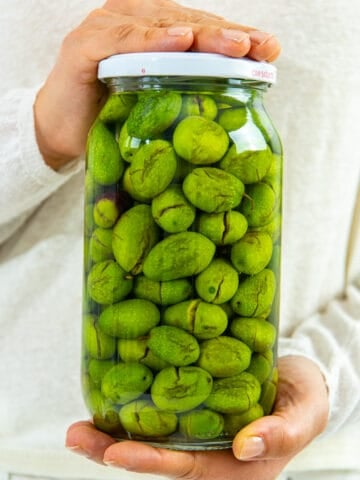
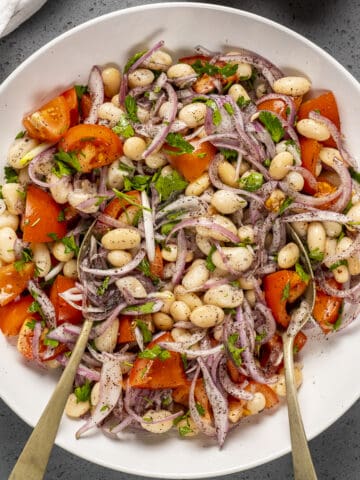
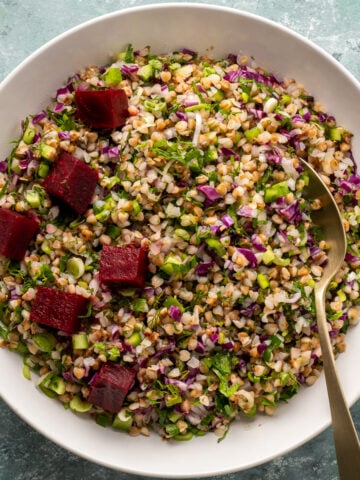
Lessie says
Do you put the lids on while the jars are hot from the brine or do you wait till the jars are cooled and putting them in the refrigerator?
Zerrin & Yusuf says
Hi Lessie,
We place the lids on the jars and let them cool down to room temperature and then put the jars in the refrigerator.
Stan says
You wrote: "If you are planning to make fermented pickles, use it [the pickling brine] cold."
This is not correct, as the vinegar in your brine recipe will inhibit the growth of the lactic-acid bacteria during lacto-fermentation. Fermentation brine is typically 4 tbsp course salt salt per quart of water (or 30gm salt to 1 liter of water), with no vinegar added.
The recipe looks fine for making vinegar pickles.
Ashima says
Hi! This looks so easy and incredible. I was wondering if I could just make the pickle brine with some spices and use it for cocktails. Would I need to make any changes and store it for a few days before using it? How long would the brine last for?
Thanks!
Zerrin & Yusuf says
Hi Ashima,
Using it in cocktails is a brilliant idea! You can use it as it is or add more spices if you want. You just need to let it cool completely before adding in the cocktails. It keeps well for up to 2 months.
Mendy says
You made pickling look and sound so easy with this brine. Tried it with chili peppers and they turned out so good! Thank you!
Zerrin & Yusuf says
Hi Mendy,
We are so happy to hear that. We LOVE pickled chili peppers!
conroy weir says
The scale for increasing amount DOES NOT WORK
Zerrin & Yusuf says
Hi Conroy,
Thank you for the heads up.
We have just fixed it. It must be working now.